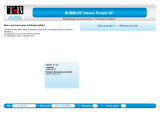
WLAN module .................................................................................................................................... 26
RTC battery ........................................................................................................................................ 28
Heat sink ............................................................................................................................................ 29
Speakers ............................................................................................................................................ 31
System board .................................................................................................................................... 32
TouchPad ........................................................................................................................................... 34
Display assembly ............................................................................................................................... 35
Power button board .......................................................................................................................... 41
Power connector cable ...................................................................................................................... 42
Keyboard/top cover ........................................................................................................................... 43
6 Using Setup Utility (BIOS) ............................................................................................................................. 44
Starting Setup Utility (BIOS) ................................................................................................................................ 44
Updating Setup Utility (BIOS) .............................................................................................................................. 44
Determining the BIOS version ........................................................................................................... 44
Downloading a BIOS update .............................................................................................................. 45
7 Specications .............................................................................................................................................. 46
Computer specications ...................................................................................................................................... 46
35.56-cm (14.0-in), HD display specications .................................................................................................... 47
8 Backing up, restoring, and recovering ........................................................................................................... 48
Creating recovery media and backups ................................................................................................................ 48
Creating HP Recovery media (select products only) ......................................................................... 48
Using Windows tools ........................................................................................................................................... 49
Restore and recovery ........................................................................................................................................... 50
Recovering using HP Recovery Manager ........................................................................................... 50
What you need to know before you get started ............................................................. 50
Using the HP Recovery partition (select products only) ................................................. 51
Using HP Recovery media to recover .............................................................................. 51
Changing the computer boot order ................................................................................ 52
Removing the HP Recovery partition (select products only) ......................................... 53
9 Using HP PC Hardware Diagnostics (UEFI) ....................................................................................................... 54
Downloading HP PC Hardware Diagnostics (UEFI) to a USB device .................................................................... 54
10 Power cord set requirements ...................................................................................................................... 56
Requirements for all countries ............................................................................................................................ 56
Requirements for specic countries and regions ................................................................................................ 56
vi




















